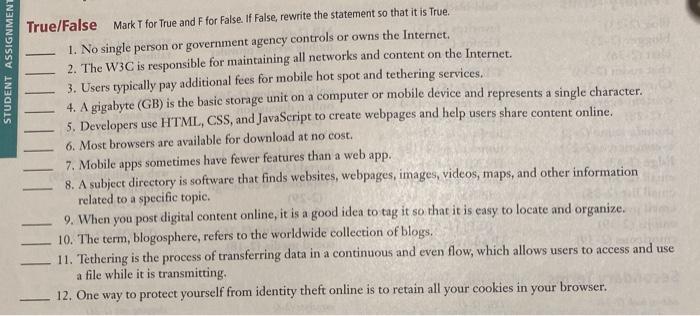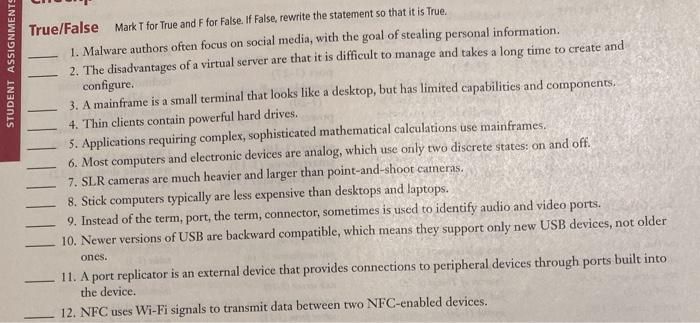STUDENT ASSIGNMENT True/False Mark T for True and F for False. If False, rewrite the statement so that it is True. 1. No single person or government agency controls or owns the Internet. 2. The W3C is responsible for maintaining all networks and content on the Internet. 3. Users typically pay additional fees for mobile hot spot and tethering services. 4. A gigabyte (GB) is the basic storage unit on a computer or mobile device and represents a single character. 5. Developers use HTML, CSS, and JavaScript to create webpages and help users share content online. 6. Most browsers are available for download at no cost. 7. Mobile apps sometimes have fewer features than a web app. . 8. A subject directory is software that finds websites, webpages, images, videos, maps, and other information related to a specific topic. 9. When you post digital content online, it is a good idea to tag it so that it is easy to locate and organize. 10. The term, blogosphere, refers to the worldwide collection of blogs. 11. Tethering is the process of transferring data in a continuous and even flow, which allows users to access and use a file while it is transmitting, 12. One way to protect yourself from identity theft online is to retain all your cookies in your browser. STUDENT ASSIGNMENTS True/False Mark T for True and F for False. If False, rewrite the statement so that it is True 1. Malware authors often focus on social media, with the goal of stealing personal information 2. The disadvantages of a virtual server are that it is difficult to manage and takes a long time to create and configure. 3. A mainframe is a small terminal that looks like a desktop, but has limited capabilities and components. 4. Thin clients contain powerful hard drives. 5. Applications requiring complex, sophisticated mathematical calculations use mainframes. 6. Most computers and electronic devices are analog, which use only two discrete states: on and off. 7. SLR cameras are much heavier and larger than point-and-shoot cameras. 8. Stick computers typically are less expensive than desktops and laptops. 9. Instead of the term, port, the term, connector, sometimes is used to identify audio and video ports. 10. Newer versions of USB are backward compatible, which means they support only new USB devices, not older ones. 11. A port replicator is an external device that provides connections to peripheral devices through ports built into the device. 12. NFC uses Wi-Fi signals to transmit data between two NFC-enabled devices








